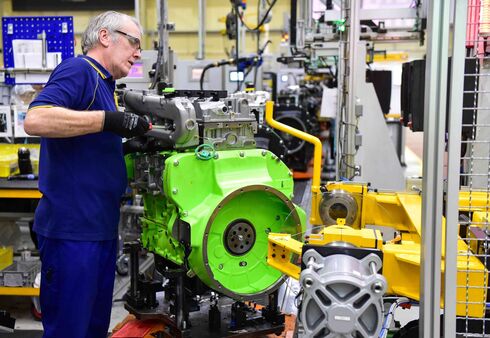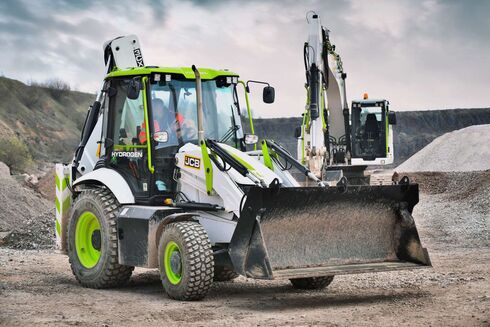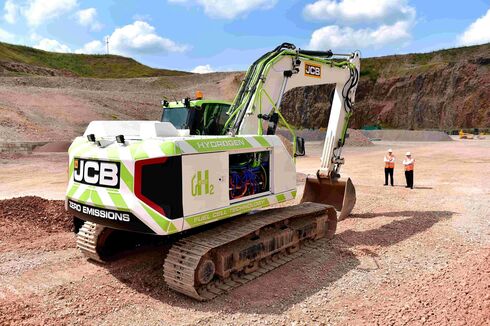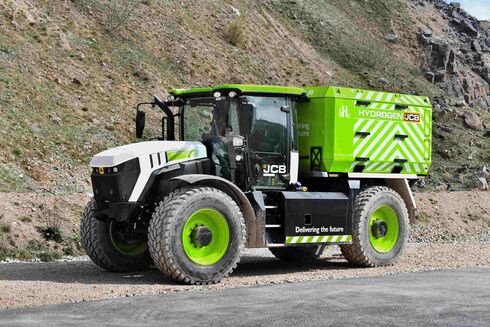
Why JCB backs hydrogen
24 January 2024

Any discussion of sustainable alternatives to fossil fuels is likely to mention hydrogen. JCB believes that it should be placed much higher on the Net Zero agenda, particularly as an option for powering heavier plant and machinery, given the current limitations of battery technologies.
Indeed, as blog followers will know, the manufacturer’s Chairman Lord Bamford recently urged industry leaders and stakeholders to get behind the government’s call for evidence on how construction plant and other site machinery might be powered in the future.
Recently I was able to attend a Hydrogen Technology Day at JCB’s engine manufacturing centre in Derbyshire, during which the company presented a strong argument for adopting the fuel more widely, as well as promoting the hydrogen internal combustion engine (ICE) it has developed, pictured above. This power unit has already been fitted successfully to a number of viable prototype machines.
Tim Burnhope, JCB Chief Innovation & Growth Officer, explained that the company has been exploring alternative fuels for many years - like other manufacturers - in the wake of emissions regulations like Stage IIIa and Stage V diesel requirements. This led to developments such as JCB’s Dieselmax engines, technology which enabled the company to undertake a successful project to achieve the world diesel-powered land speed record in 2006, in a vehicle driven to over 350mph.
However, legislation initially focused on reducing particulates like NOx (nitric oxide and nitrogen dioxide) rather than carbon, which is now seen as the main challenge on the route to Net Zero. By contrast, when hydrogen burns, the only by-product is water, making it an attractive option.
JCB believes that the fuel should be considered more seriously alongside a range of power sources, including batteries and cleaner diesel alternatives, with the choice depending on the task in hand and the nature of the work site (something the Site-Eco blog has argued consistently).
Giving an initial overview, Tim Burnhope said that JCB’s product range encompasses 16 main machine categories with 350 different products of up to 50 tonnes. The individual characteristics of each dictated which fuel would be the best as a diesel alternative.
Larger, heavier models requiring more power would naturally produce the greatest emissions, especially as some products like excavators might be used virtually round-the-clock in multiple shifts in order for users to obtain maximum productivity.
Lithium-ion batteries, he said, provide a practical option for smaller machines like mini excavators and compact dumpers which can be recharged overnight. Bur for larger plant that needs to be ready for work again quickly, something resembling the traditional quick-flll characteristics associated with using diesel fuel is needed.
Such an energy source also has to provide the rapid power response and cycle times that fossil fuel powered engines have traditionally delivered for the operator.
However, the batteries needed to power, say, a 20-tonne excavator would perhaps weigh 10 tonnes themselves. This would increase the host machine’s size and weight significantly, as well as costing at least four times more.
The electricity supply infrastructure would also need to be capable of meeting charging demand, and as construction equipment is often used in remote areas or on new-build projects without mains connections, these are significant challenges to overcome.
Tim Burnhope explained that JCB had researched into several alternative fuels. HVO (hydrogenated vegetable oil) can replace diesel, but questions remain in some quarters regarding its green credentials. Other alternatives like biogas derived from methane, synthetic e-fuels from hydrocarbons and ammonia also posed challenges. Most of these also require the production of hydrogen as a source material.
JCB’s earliest research into hydrogen power included developing a 20-tonne excavator (shown below) using a hydrogen fuel cell to charge a battery. However, the technology was found to have drawbacks.
For a start, the fuel cell itself cost some £100,000. It also needed a dedicated cooling pack requiring 20kW of power and special coolant, along with a DC/DC converter, specific motors and inverters, as well as dedicated electronics that were challenging to work on in the field.
The resultant machine that JCB developed cost four times the price of its diesel equivalent and, being technologically complex, it has not surprisingly been ‘parked’.
Nevertheless, the clear need for a practical alternative to meet user’s needs led Lord Bamford to issue a challenge in 2020 for the company to produce within six months an engine fuelled by hydrogen gas injected into the combustion chamber along with compressed air.
This was in many ways new technological territory for JCB, since it is famous for its diesel equipment using engines that ignite by compression rather than a spark.
Hydrogen can be produced in several ways, each with different environmental implications. Basically, splitting methane gives ‘grey’ hydrogen, while ‘blue’ hydrogen is produced by removing carbon from hydrocarbons and capturing it. Green hydrogen is made by electrolysing water, which requires considerable electrical power, perhaps harnessed by solar panels and wind turbines.
During the Hydrogen Technology Day, Paul McCarthy, JCB’s Chief Engineer Power Systems, explained how the company went back to first principles and looked at no fewer than 76 technical and academic papers on hydrogen powered ICEs.
He said that four main challenges had been identified: the flow of gas in the combustion chamber; the compression of air, which needs to be denser than the fuel; spark ignition at relatively low temperatures and pressures; and dealing with water as a by-product.
The end result is a 55kW engine of 4.8 litres, which JCB says can be used in around 70% of its diesel machine portfolio, with the same dimensions and power/torque characteristics. Its performance has been assessed and monitored in special test cells at the production plant in Derbyshire, simulating a range of operating conditions.
As mentioned previously on the blog, JCB has produced hydrogen ICE-powered versions of its iconic 3CX backhoe loader, shown below, and a Loadall telescopic handler.
The company has also developed a bowser refuelling system. This allows hydrogen to be taken from on-site tube trailers and distributed to machines as they work on a job site, and this recognises the fact that around 97% of traditional construction machines have fuel delivered for refilling in a process that takes a matter of minutes.
Hydrogen is commonly perceived as potentially explosive – not least because of the impressive experiments that many of us witnessed in school chemistry lessons. However, JCB points out that the gas is the lightest element in the periodic table and that any leak would very quickly disperse upwards at a speed of 40mph and out of harm’s way.
So, many see hydrogen as the fuel of the future for power-hungry, large-scale energy demands.
But one of the challenges is the current lack of infrastructure to create the fuel at scale and to distribute it. Tim Burnhope says that rules and regulations relating to fuel sources and uses have typically been focused around battery technology, perhaps because that is what most people are familiar with; but it is doubtful whether large-scale power demands can be met in a practical way.
JCB is confident that its hydrogen ICE represents a viable solution, one that is derived from technology which people are familiar with.
Many will be watching carefully to see how new energy regulations and infrastructure plans develop in the future and how far they meet the aspirations of manufacturers focused on hydrogen solutions.
● As previously reported, the UK government is seeking evidence on how site machinery might decarbonise as part of its Net Zero ambitions. To participate click on this link. Rental companies are amongst the industry stakeholders that the government is inviting responses from – but be quick: you need to act before the submission deadline of 26 March.




